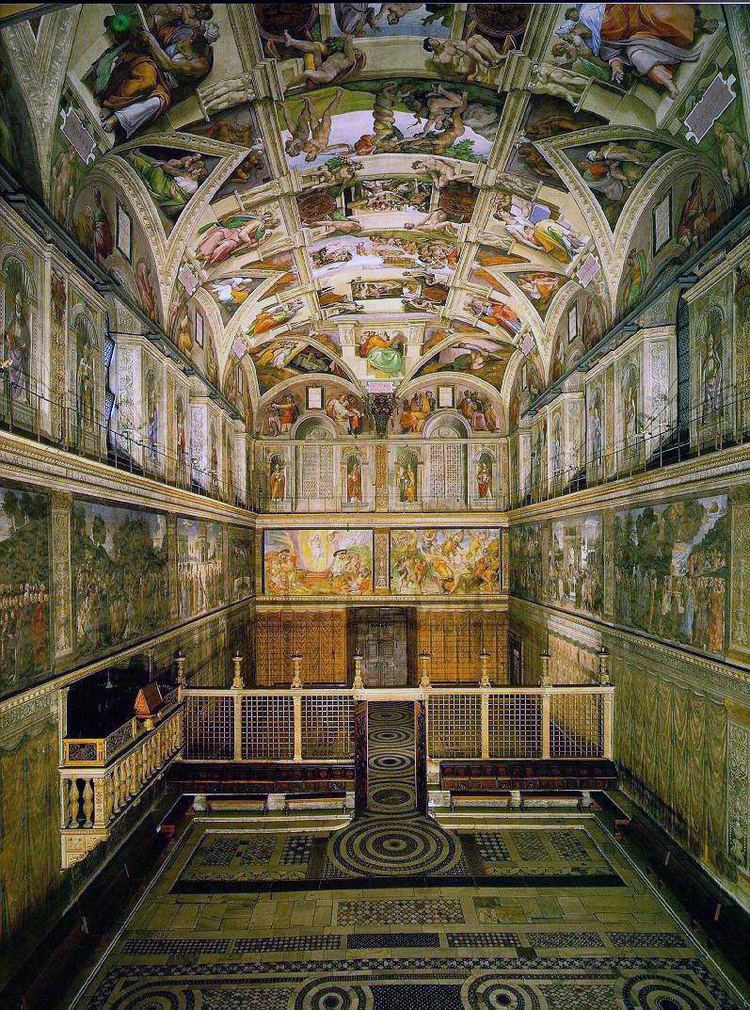 | ||
Miserere (full title: Miserere mei, Deus, Latin for "Have mercy on me, O God") is a setting of Psalm 51 (50) by Italian composer Gregorio Allegri. It was composed during the reign of Pope Urban VIII, probably during the 1630s, for use in the Sistine Chapel during matins, as part of the exclusive Tenebrae service on Holy Wednesday and Good Friday of Holy Week.
Contents
Description and use
The Miserere is written for two choirs, one of five and one of four voices, and is an example of Renaissance polyphony. One of the choirs sings a simple version of the original Miserere chant; the other, spatially separated, sings an ornamented commentary on this.
The Tenebrae service where the Miserere would be sung normally began at dusk, hence the name (tenebrae is Latin for "shadows" or "darkness"). During the ritual, candles would be extinguished one by one, save for the last candle which remained alight and was then hidden. Allegri envisioned the setting of the Miserere to be the final act within the first lesson of the Tenebrae service.
History
It was the last of twelve falsobordone Miserere settings composed and chanted at the service since 1514 and is the most popular.
At some point, it became forbidden to transcribe the music and it was allowed to be performed only at those particular services at the Sistine Chapel, thus adding to the mystery surrounding it.
The setting that escaped from the Vatican is actually a conflation of verses set by Gregorio Allegri around 1638 and Tommaso Bai (also spelled "Baj"; 1650–1718) in 1714.
Three authorized copies of the work were distributed prior to 1770: to the Holy Roman Emperor, Leopold I; to the King of Portugal; and to Padre (Giovanni Battista) Martini. However, none of them succeeded in capturing the beauty of the Miserere as performed annually in the Sistine Chapel. According to the popular story (backed up by family letters), fourteen-year-old Wolfgang Amadeus Mozart was visiting Rome when he first heard the piece during the Wednesday service. Later that day, he wrote it down entirely from memory, returning to the Chapel that Friday to make minor corrections. Less than three months after hearing the song and transcribing it, Mozart had gained fame for the work and was summoned to Rome by Pope Clement XIV, who showered praise on him for his feat of musical genius and awarded him the Chivalric Order of the Golden Spur. Some time during his travels, he met the British historian Charles Burney, who obtained the piece from him and took it to London, where it was published in 1771. The work was also transcribed by Felix Mendelssohn in 1831 and Franz Liszt, and various other 18th and 19th century sources survive. Since the lifting of the ban, Allegri's Miserere has become one of the most popular a cappella choral works now performed.
The original ornamentation that made the work famous were Renaissance techniques that preceded the composition itself, and it was these techniques that were closely guarded by the Vatican. Few written sources (not even Burney's) showed the ornamentation, and it was this that created the legend of the work's mystery. However, the Roman priest Pietro Alfieri published an edition in 1840 with the intent of preserving the performance practice of the Sistine choir in the Allegri and Bai compositions, including ornamentation.
Recordings
The Miserere is one of the most frequently recorded pieces of late Renaissance music. An early and celebrated recording of it is the one from March 1963 by the Choir of King's College, Cambridge, conducted by Sir David Willcocks, which was sung in English and featured the then-treble Roy Goodman. This recording was originally part of a gramophone LP recording entitled Evensong for Ash Wednesday but the Miserere has subsequently been re-released on various compilation discs.
Historically informed recordings have been released by the Sixteen, the Tallis Scholars and, more recently, Tenebrae.
In 2015 the Sistine Chapel choir released their first CD, including the 1661 Sistine codex version of the Miserere recorded in the chapel itself.
Original
The original translation of the psalm used for the piece was in Latin:
English translation
This translation is from the 1662 Book of Common Prayer and is used in Ivor Atkins' English edition of the Miserere (published by Novello):
